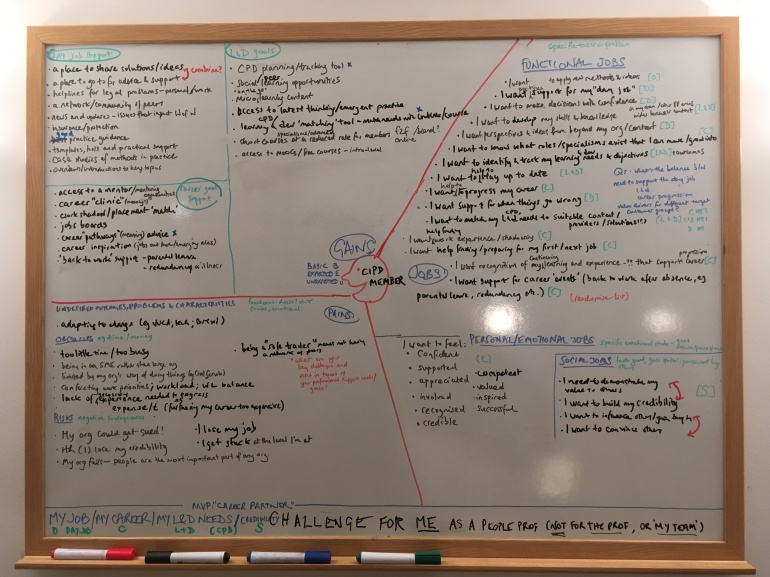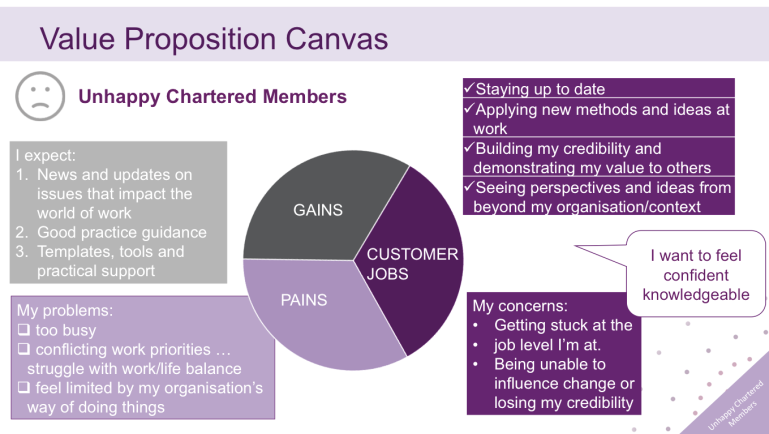When I took on the role of Head of Customer Experience back in 2017 I panicked slightly. At that time I didn’t feel that I knew anything about the CIPD’s members, despite having already worked for the CIPD for a couple of years.
The big questions that I (and the CIPD) needed to answer were ‘Who are our members?’ and ‘What are their needs?’ and ‘Are we meeting those needs?’
In the first of this two-part blog post, I’m going to reveal the CIPD’s efforts to begin to answer those questions.
Back to Basics
As I’ve blogged previously, analysis of the dissatisfied scores from the CSAT question in our brand perception survey (see also the forthcoming Hug Your Haters blog post) showed that some members felt that their membership fee wasn’t value for money and that membership wasn’t relevant to them and their work.
The next step for the Customer Experience team was to understand what value and relevance actually looks like for our members.
In the summer of 2018 we started planning our member survey. The survey was intended to inform a number of key and emergent organisational strategies, but it was also a chance to go back to basics in terms of understanding our members’ basic needs.
The Value Proposition Canvas
We did that by taking a Value Proposition Canvas approach to understanding our members’ context, challenges and what they’re looking for from their CIPD membership.

The Value Proposition has two sides. With the Customer Profile you clarify your customer understanding. With the Value Map you describe how you intend to create value for that customer. You achieve Fit between the two when one meets the other. (Value Proposition Design, Osterwlder et. al)
Customer Profile: Jobs To Be Done
The Value Proposition Canvas begins with describing the customers’ ‘jobs’, and has its roots in Clayton Christensen’s ‘Jobs to be done’ theory.
Jobs are the things your customer is trying to get done (rather than their formal ‘work’ role). Or as Clayton Christensen puts it:
“Job” is shorthand for what an individual really seeks to accomplish in a given circumstance. (Clayton Christensen)
Christensen argues that ‘When we buy a product, we essentially “hire” it to help us do a job’. If the product does it well we tend to ‘hire’ that product again, if it doesn’t we tend to ‘fire’ it and look for an alternative product. Now members can’t ‘hire’ and ‘fire’ membership per se quite so easily, but they can certainly ‘hire’ (use) and ‘fire’ (stop using) the member benefits on offer. (And we know from our research that there’s a correlation between the number of benefits a member uses and higher levels of customer satisfaction.)
Jobs are never simply about function—they have powerful social and emotional dimensions. (Clayton Christensen)
Jobs fall into three main types:
- functional jobs – the things your customer does to perform or complete a specific task or solve a particular problem;
- social jobs – the things the customer does to look good or gain status, for example to be perceived as competent or knowledgeable;
- personal and emotional jobs – the things the customer does to achieve a specific emotional state, for example to feel secure.
It’s also important to understand the level of importance a job has to your customer. Some matter more and failing to fulfil them could have serious consequences, some are less important.
Customer ‘Pains’
Pains describe anything that annoys your customers before, during and after trying to get a job done or simply prevents them from getting a job done. Pains also describe risks (potential bad outcomes). (Value Proposition Design, Osterwlder et. al)
It’s also important to understand the level of severity the pain has to your customer.
Customer ‘Gains’
Gains describe the outcome and benefits your customer want. (Value Proposition Design, Osterwlder et. al)
Gains can be:
- required – gains that without which a solution wouldn’t work;
- expected – the things a customer expectsfrom a solution;
- desired – the things that go beyond what’s expected, but that a customer would like to have;
- unexpected – the things that go beyond expectations and desires; an opportunity to delight your customer.
Designing the survey
We started the process with a number of in-depth interviews with members from a variety of grades, backgrounds, job roles and ages. We structured the questions in a way that would help us to design the questions in the survey later. We needed qualitative data that we could then validate with a quantitative method – i.e. a survey.
We wanted to know what were members’ jobs to be done, including their social and emotional jobs? We asked them to describe the ‘pains’ they encounter in their professional life and what help they look to the CIPD to provide, or would like the CIPD to help them with.
These interviews were written up and provided the source material for our survey questions.
We began by asking ourselves, what were CIPD members’ ‘jobs to be done’ (JTBD)?
The CIPD’s brand promise is to be our members’ ‘career partner’. So we took that brand promise and broke it into five main JTBDs:
- day-to-day role as a people professional;
- learning needs including their ‘continuing professional development’ needs;
- career progression;
These all comprise members’ functional jobs. Plus:
- social – how members want to be perceived in their professional life;
- emotional – how they want to feel.
We then distilled the insights from the interviews into statements on a generic value map.

And from there we designed our questions.
So what did we learn?
Once we’d got the results of the survey in, we analysed the data and built customer profiles for all of our existing ‘priority’ customer groups – for example ‘senior leaders/influencers’; ‘risky Associates’ (we know that members in Assoc grade who have been in membership for 1-3 years have the highest lapse rates), and ‘unhappy Chartered Members’ (the grade most likely to give us lowest satisfaction scores). We can cut the data any way we like, and the team are currently using various statistical modelling techniques to develop more sophisticated, value-driven profiles, from which we’ll build out data-driven personas. (More on this soon!)

A Customer Profile for Chartered Members
So for example, Chartered Members’ top JTBD are around staying up to date, applying new methods and ideas (functional jobs) and building their credibility (social jobs). They also want to feel confident and knowledgeable (emotional jobs).
We asked questions to understand their pains – what were their main difficulties and challenges, what barriers are they facing?
They’re concerned about:
- Getting stuck at the job level they’re in;
- Being unable to influence change;
- Losing credibility.
They also told us that:
- They’re too busy;
- They have conflicting work priorities and struggle with work/life balance;
- They feel limited by their organisation’s way of doing things.
And we asked what are the ‘gains’ – the outcomes and benefits – that they’re looking for from CIPD? And whether those gains are expected, desired or unexpected.
We found that Chartered Members expect CIPD to keep them up to date, give them good practice guidance, and practical support – these are the basics that CIPD must get right in terms of its member value proposition for this group.
We also asked what gains they’d like to have (desired) and would be delighted to have (unexpected) – so we know where we can start to add value once we’re sure we’re getting the basics right.
In fact we found that the expected level of support (or ‘gains’) from the CIPD was very similar across all of our members. First and foremost they’re looking for support for the things that relate to their day-to-day role (expected gains) followed by their learning/CPD needs (would like to have) and then career progression support (would be delighted to have).
Building a better understanding of our members
So using the Jobs To Be Done (JTBD) theory and using qualitative and quantitative research methods has already helped us to understand our members far better than we ever have in the past, as well as to build customer profiles for our customer groups (which we intend to further refine and validate in the coming weeks).
In the second of this two part blog post I’ll explore how we’ve begun to map customer profiles to membership value, how we’re using JTBD insight in marketing campaigns and how finding out what ‘membership’ means to your members can help pinpoint where to improve your member value proposition.
Thank you
As ever, a huge thank you to the CIPD’s Customer Experience team for your passion, ideas, creativity and hard work. This is your story.
—
Main image: the designers at intercom (intercom.com) use this illustration to show what is, and isn’t, important to customers (Source: JTBD.info)

